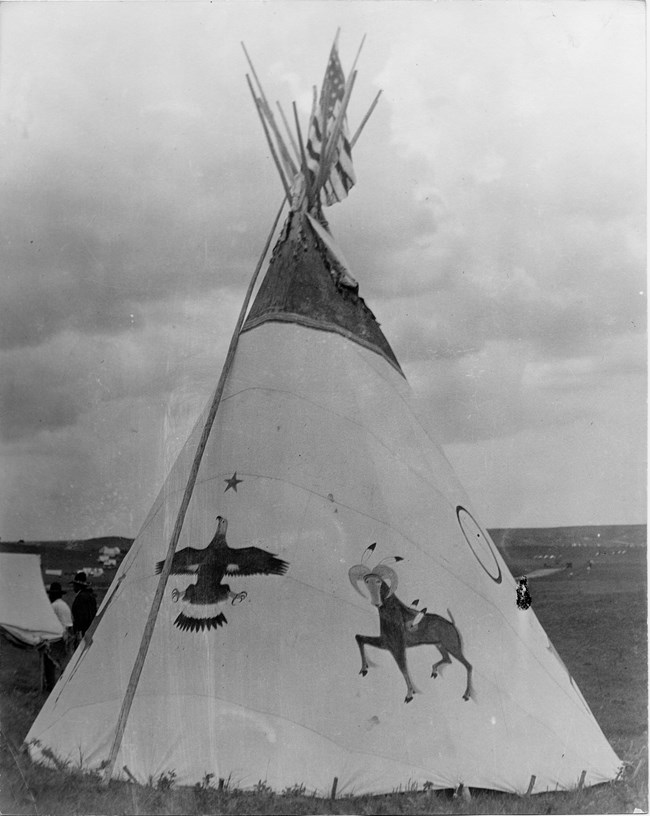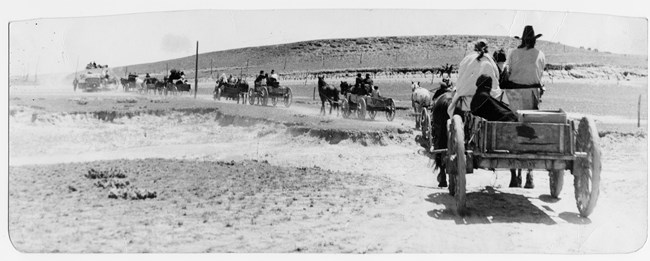Part of a series of articles titled History & Culture in the Badlands.
Previous: Homesteading in the Badlands
Article
The Dawes Act (sometimes called the Dawes Severalty Act or General Allotment Act), passed in 1887 under President Grover Cleveland, allowed the federal government to break up tribal lands. The federal government aimed to assimilate Native Americans into mainstream US society by encouraging them towards farming and agriculture, which meant dividing tribal lands into individual plots. Only the Native Americans who accepted the division of tribal lands were allowed to become US citizens. This ended in the government stripping over 90 million acres of tribal land from Native Americans, then selling that land to non-native US citizens.

NPS Photo
If they accepted the allotment divisions, the Dawes Act designated 160 acres of farmland or 320 acres of grazing land to the head of each Native American family. These acreages were comparable to those promised by the Homestead Act, but there were important differences between the two acts. Tribes already controlled the land that was being returned to them at a fraction of the acreage, Native Americans were not accustomed to a life of standardized ranching and agriculture, and the lands allotted to them were often unsuitable for farming.
In order to receive their allotment, Native Americans were required to enroll with the Office of Indian Affairs, now known as the Bureau of Indian Affairs (BIA). By enrolling, the individual registered themselves with the office and their name went on the “Dawes rolls,” which assisted government agencies in determining whether or not that individual was eligible to receive their allotment.
Although Native Americans controlled about 150 million acres of land before the Dawes Act, they lost the majority of it due to these allotment divisions and selling of surplus. When tribes were paid for their land, they were underpaid. In addition to scant payment, Native Americans were not used to spending money and quickly spent most of what they received. Many were left with little land and little money. Inheritance also became an issue for many Native Americans who enrolled to receive land from the Dawes Act. When young children received allotments, some did not know how to farm because they had spent their youth in boarding schools. When there were multiple inheritors, the size of the plots was too small to divide among children and still be suitable for farming.

NPS Photo
Assimilation was a major goal of Native American policies in the late 19th century. Assimilation is the process of taking individuals or social groups and absorbing them into mainstream culture.
After families claimed their allotments, any remaining tribal lands were declared “surplus” land. These lands were then sold off to non-native settlers. Additional legislation like the Homestead Acts further encouraged white settlement of the West, and with that settlement came calls for assimilation. Many settlers viewed native practices as barbaric and primitive, seeing assimilation as the only option for coexistence.
The US government employed a variety of methods in the attempt to assimilate Native Americans, including the Dawes Act. The desired effect of the Dawes Act was to get Native Americans to farm and ranch like white homesteaders. An explicit goal of the Dawes Act was to create divisions among Native Americans and eliminate the social cohesion of tribes.
Part of a series of articles titled History & Culture in the Badlands.
Previous: Homesteading in the Badlands